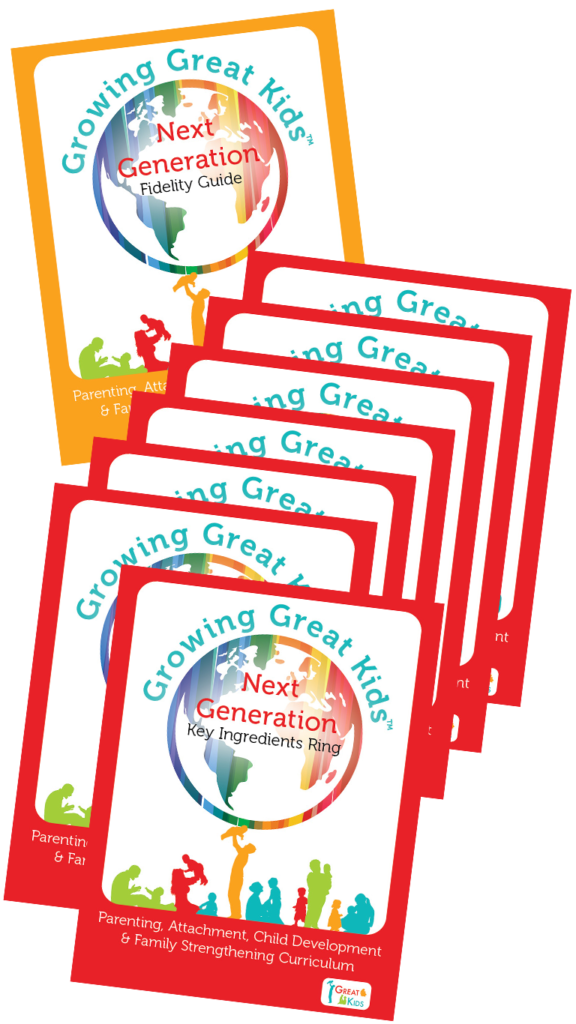 | | | | About the Author Melissa Weekes is a Product Development Specialist. Prior to joining Great Kids® in 2018, she worked as a home visitor with Public Health Services where she used the Growing Great Kids® Curriculum. Melissa lives in Nova Scotia, Canada, with her husband and enjoys any opportunity to be creative! |
So much for lazy summer days! If your family is like mine, the hustle and bustle of summer is in full swing. There are activities to go to, yardwork to keep up with, and general maintenance tasks to get done. In these busy days, family dynamics ebb and flow with the push and pull of trying to get things done and be in other places. Family roles shift and adapt to the tasks at hand, and often communication falls into bulleted-list type information exchanges on the fly rather than in-depth dialogues!
While not all families change with the physical seasons, most families experience shifts in dynamics during the different seasons of life. Whether it’s caring for a newborn, running kids to sports practices and games, nurturing aging parents, or focusing on school or a career, family members shift and adjust to keep the family functioning.
Interestingly, researchers describe the family unit as a SYSTEM, where individual members depend on and respond to one another.2,4
Like a hanging mobile, when one part moves, it affects the other mobile pieces.2 While all families can likely relate to this analogy, it’s especially relevant for families experiencing a substance use disorder.
When a family member has a substance use disorder, it causes a shift in the family system that requires the other family members to adjust to keep the family stable.2,4 For example, a partner might work extra hours to cover the bills, or an older child might take on more of a parenting role with younger siblings or even “parent their parent.”2
Each family unit also has unique dynamics around communicating and maintaining boundaries.2,4 When a family member experiences a substance use disorder, unhealthy communication patterns or unspoken rules can develop, and boundaries can break down in some areas or become rigid in others.2,4 Despite all this, family members try to function and keep the family balanced as best they can.4
But what happens when an individual with substance use disorder enters recovery?
A common misconception is that everything in the family will automatically improve. However, I was surprised to learn from the experts that when an individual is in recovery, their family is ALSO in recovery.1 For many, this can be a difficult adjustment. Suddenly, the way the family was functioning before doesn’t work anymore. Like the hanging mobile, the family must shift to find a NEW balance again.4 Often, this involves establishing new routines, finding ways to share responsibilities, and learning different ways to communicate so the family can function more healthily.1,4
It’s important for each family member to feel supported as they make these shifts and adjustments. This is one reason accredited substance use disorder treatment programs now include some level of family involvement. The whole family system needs to be supported to experience healing and recovery. Unfortunately, statistics tell us that only about 10% of people with substance use disorder access treatment, leaving many families without any support.3
However, knowledge is power, and when families learn more about substance use disorder and recovery, they can be empowered to connect with support and strengthen their families.
As many of you know, supporting families is what Great Kids® is all about. We have just released TWO new FAMILY-STREGTHENING curriculums that professionals can use to support families.
Hope at Home is a family-strengthening curriculum specific to parents in recovery from substance use disorder. This manual supports you in addressing the challenges families in recovery face through open, nonjudgmental, and authentic conversations that normalize and give parents HOPE. Some of the topics in this manual include:
- Attachment,
- Learning Healthy Ways of Coping,
- The Connection Between Substance Use and Mental Health,
- Recognizing and Reducing Unhealthy Stress, and
- Self-regulation.
You can learn more about Hope at Home here.
Growing Great Families® Next Generation is a curriculum that can be used with ANY family to strengthen family relationships, manage stress, and grow parenting skills. Some of the topics in this manual include:
- Shaping Your Child’s Future,
- Defining and Living Your Family Values,
- Celebrating Family Traditions and Culture,
- Protecting Your Child From Toxic Stress, and
- Parenting Partnerships.
You can learn more about Growing Great Families® Next Generation here.
The great thing about these family-strengthening curriculums is that there are no prerequisites for using these manuals. If you are someone that supports families in any way, these manuals have the potential to become your new best friend. And in the hustle and bustle of busy summer life, you may just find some handy tips for strengthening your own family, too.
References:
1. Center for Substance Abuse Treatment. (2004). What is substance abuse treatment? A booklet for families: HHS publication no. (SMA) 14-4126. SAMHSA. https://store.samhsa.gov/sites/default/files/d7/priv/sma14-4126.pdf
2. Lander, L., Howsare, J., & Byrne, M. (2013). The impact of substance use disorders on families and children: From theory to practice. Social Work in Public Health, 28(3-4), 194-205. https://doi.org/10.1080/19371918.2013.759005
3. National Institute on Drug Abuse. (2022, March 28). NIDA IC fact sheet 2023. https://nida.nih.gov/about-nida/legislative-activities/budget-information/fiscal-year-2023-budget-information-congressional-justification-national-institute-drug-abuse/ic-fact-sheet-2023
4. Substance Abuse and Mental Health Services Administration. (2020). Substance use disorder treatment and family therapy: Treatment improvement protocol (TIP) series no. 39. SAMHSA publication no. PEP20-02-02-012. https://store.samhsa.gov/sites/default/files/SAMHSA_Digital_Download/PEP20-02-02-012-508%20PDF.pdf


